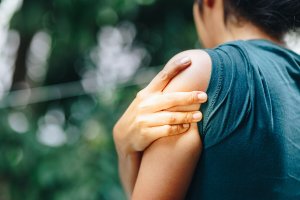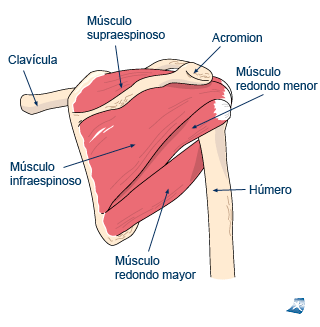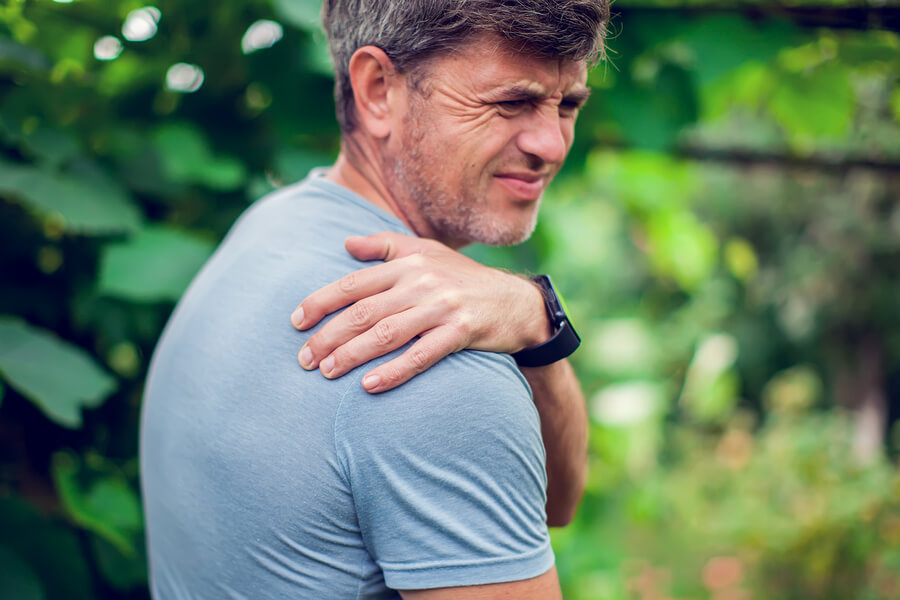The Most Frequent Rotator Cuff Injuries

It’s important to know the common sports injuries that you can suffer from, in order to avoid them. In sports, there’s a high demand for training the upper body. The shoulder is one of the most vulnerable joints in that area. Read along to find out about the most common rotator cuff injuries.
What’s the rotator cuff?
The shoulder is one of the most mobile joints in the body. As a result, certain movements can cause injuries.
The deltoid is the main shoulder muscle. A group of muscles comprises the rotator cuff and they’re responsible for internally and externally rotating the shoulders. The following are the muscles that make up the rotator cuff:
- Supraspinatus: this muscle originates in the scapula, in a region known as the supraspinatus fossa. It’s connected to the greater tubercle of the largest bone in the arm (the humerus). It’s responsible for arm abduction.
- Infraspinatus: this muscle also originates in the scapula. Specifically from the infraspinatus fossa, it’s inserted next to the supraspinatus. It’s responsible for external rotation.
- Lesser round: this is a smaller muscle than the previous two. It originates and inserts in the same area as the infraspinatus. It’s also responsible for external rotation.
- Subscapular: this is the only muscle that’s inserted in the anterior part of the body. It originates in the subscapular fossa of the scapula and located in the smaller tubercle of the humerus. This is the only internal rotator of the rotator cuff.

Most common injuries
The following are the most common rotator cuff injuries:
Tendonitis
These four words have been heard and read in many medical reports. However, we’d like to point out that this terminology is completely wrong.
The suffix ‘itis’ indicates inflammation of a given region. When we talk about tendinitis, we’re referring to inflammation of the tendon.
Tendons have no irrigation and therefore, they cannot be inflamed. It’s correct, however, to use the term tendinosis or tendinopathy. These terms refer to the inflammation of structures adjacent to the tendon.
Tendinopathy and tendinosis
As we previously mentioned, the correct term to refer to pathologies that affect the tendons or muscles of the rotator cuff is tendinopathy. The most frequent tendinopathies are those of the supraspinatus tendon and its adjacent structures. This includes the muscle tissue itself.
This injury is caused by repetitive movements. It’s very common in certain professions and in athletes who perform strength training. Tendon injuries can cause similar symptomatology.

The indicated treatment is rest and anti-inflammatory medication. Treatment may be through tablets or injections. In certain cases, these pathologies require surgery. Active rehabilitation through physiotherapy and acupuncture could also be useful.
Ruptures
Muscle or tendon rupture of any of the four muscles is a serious rotator cuff injury. This occurs if muscles or tendons are worn.
If there’s tendinopathy, it’s important to stop stressing the tendon. If tendons or muscles are stressed too much, it could lead to a rupture or tear.
The treatment for ruptures is usually surgical. Physiotherapy treatments are only indicated in older people or when the surgery presents more risks than benefits.
It’s important to know the common sports injuries that you can suffer from, in order to avoid them. In sports, there’s a high demand for training the upper body. The shoulder is one of the most vulnerable joints in that area. Read along to find out about the most common rotator cuff injuries.
What’s the rotator cuff?
The shoulder is one of the most mobile joints in the body. As a result, certain movements can cause injuries.
The deltoid is the main shoulder muscle. A group of muscles comprises the rotator cuff and they’re responsible for internally and externally rotating the shoulders. The following are the muscles that make up the rotator cuff:
- Supraspinatus: this muscle originates in the scapula, in a region known as the supraspinatus fossa. It’s connected to the greater tubercle of the largest bone in the arm (the humerus). It’s responsible for arm abduction.
- Infraspinatus: this muscle also originates in the scapula. Specifically from the infraspinatus fossa, it’s inserted next to the supraspinatus. It’s responsible for external rotation.
- Lesser round: this is a smaller muscle than the previous two. It originates and inserts in the same area as the infraspinatus. It’s also responsible for external rotation.
- Subscapular: this is the only muscle that’s inserted in the anterior part of the body. It originates in the subscapular fossa of the scapula and located in the smaller tubercle of the humerus. This is the only internal rotator of the rotator cuff.

Most common injuries
The following are the most common rotator cuff injuries:
Tendonitis
These four words have been heard and read in many medical reports. However, we’d like to point out that this terminology is completely wrong.
The suffix ‘itis’ indicates inflammation of a given region. When we talk about tendinitis, we’re referring to inflammation of the tendon.
Tendons have no irrigation and therefore, they cannot be inflamed. It’s correct, however, to use the term tendinosis or tendinopathy. These terms refer to the inflammation of structures adjacent to the tendon.
Tendinopathy and tendinosis
As we previously mentioned, the correct term to refer to pathologies that affect the tendons or muscles of the rotator cuff is tendinopathy. The most frequent tendinopathies are those of the supraspinatus tendon and its adjacent structures. This includes the muscle tissue itself.
This injury is caused by repetitive movements. It’s very common in certain professions and in athletes who perform strength training. Tendon injuries can cause similar symptomatology.

The indicated treatment is rest and anti-inflammatory medication. Treatment may be through tablets or injections. In certain cases, these pathologies require surgery. Active rehabilitation through physiotherapy and acupuncture could also be useful.
Ruptures
Muscle or tendon rupture of any of the four muscles is a serious rotator cuff injury. This occurs if muscles or tendons are worn.
If there’s tendinopathy, it’s important to stop stressing the tendon. If tendons or muscles are stressed too much, it could lead to a rupture or tear.
The treatment for ruptures is usually surgical. Physiotherapy treatments are only indicated in older people or when the surgery presents more risks than benefits.
All cited sources were thoroughly reviewed by our team to ensure their quality, reliability, currency, and validity. The bibliography of this article was considered reliable and of academic or scientific accuracy.
- McCreesh, K. M., Purtill, H., Donnelly, A. E., & Lewis, J. S. (2017). Increased supraspinatus tendon thickness following fatigue loading in rotator cuff tendinopathy: potential implications for exercise therapy. BMJ Open Sport & Exercise Medicine, 3(1), e000279. https://doi.org/10.1136/bmjsem-2017-000279
- Littlewood, C., Ashton, J., Chance-Larsen, K., May, S., & Sturrock, B. (2012). Exercise for rotator cuff tendinopathy: a systematic review. Physiotherapy, 98(2), 101–109. https://doi.org/10.1016/j.physio.2011.08.002
- Varacallo, M., & Mair, S. D. (2019). Rotator Cuff Syndrome. Retrieved from https://www.ncbi.nlm.nih.gov/books/NBK531506/
- Spargoli, G. (2019). TREATMENT OF ROTATOR CUFF TENDINOPATHY AS A CONTRACTILE DYSFUNCTION. A CLINICAL COMMENTARY. International Journal of Sports Physical Therapy, 14(1), 148–158. Retrieved from http://www.ncbi.nlm.nih.gov/pubmed/30746301
This text is provided for informational purposes only and does not replace consultation with a professional. If in doubt, consult your specialist.








